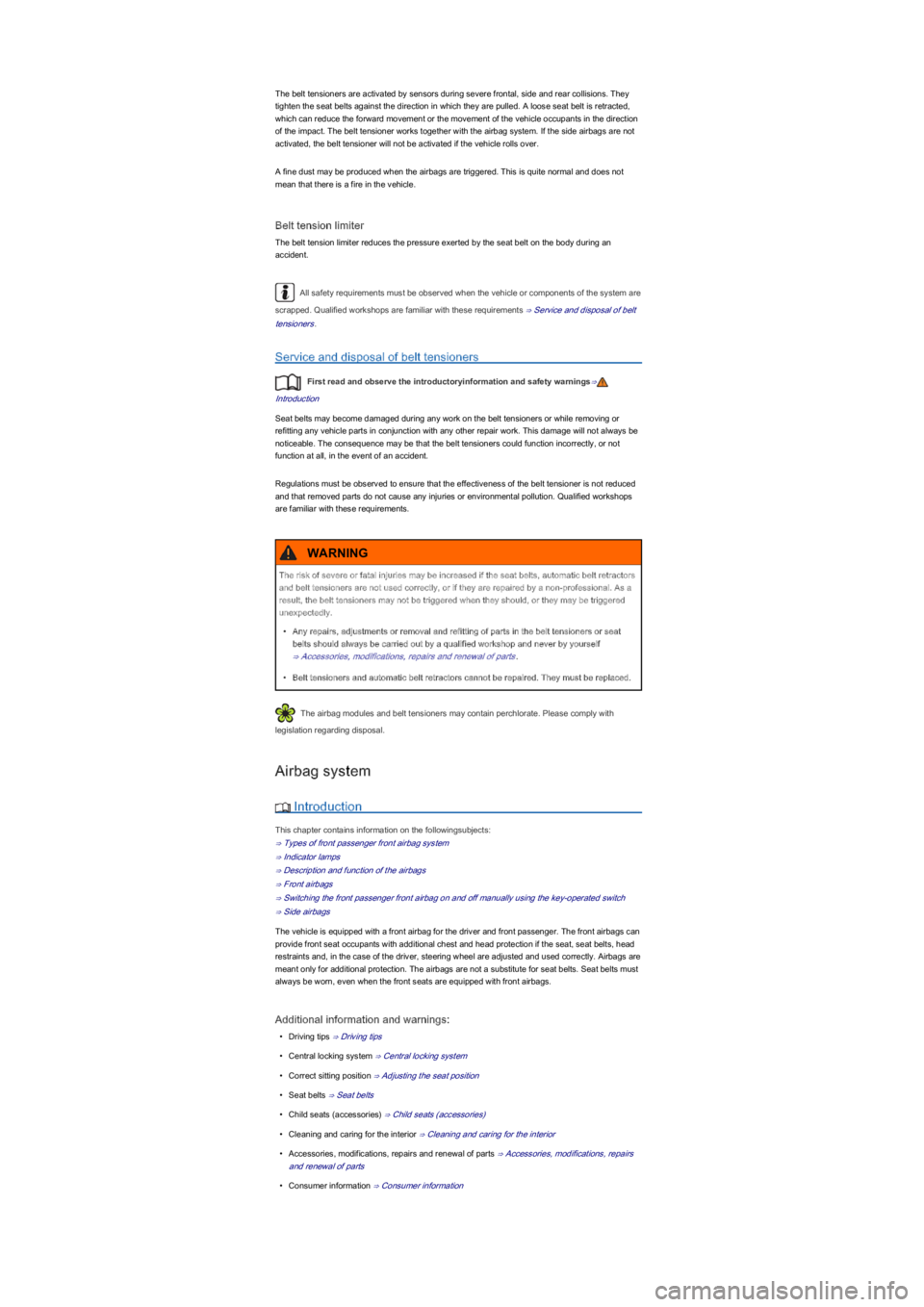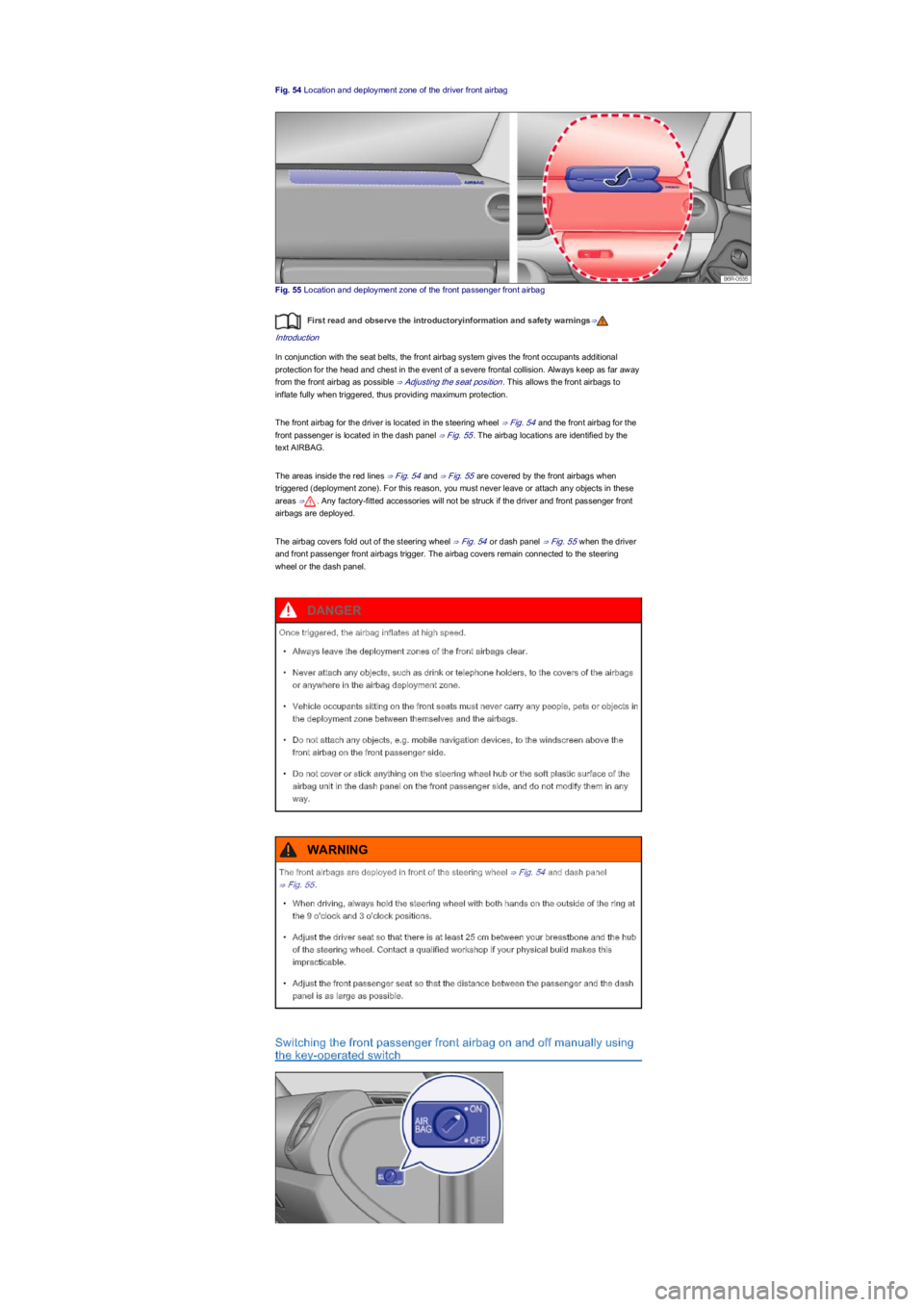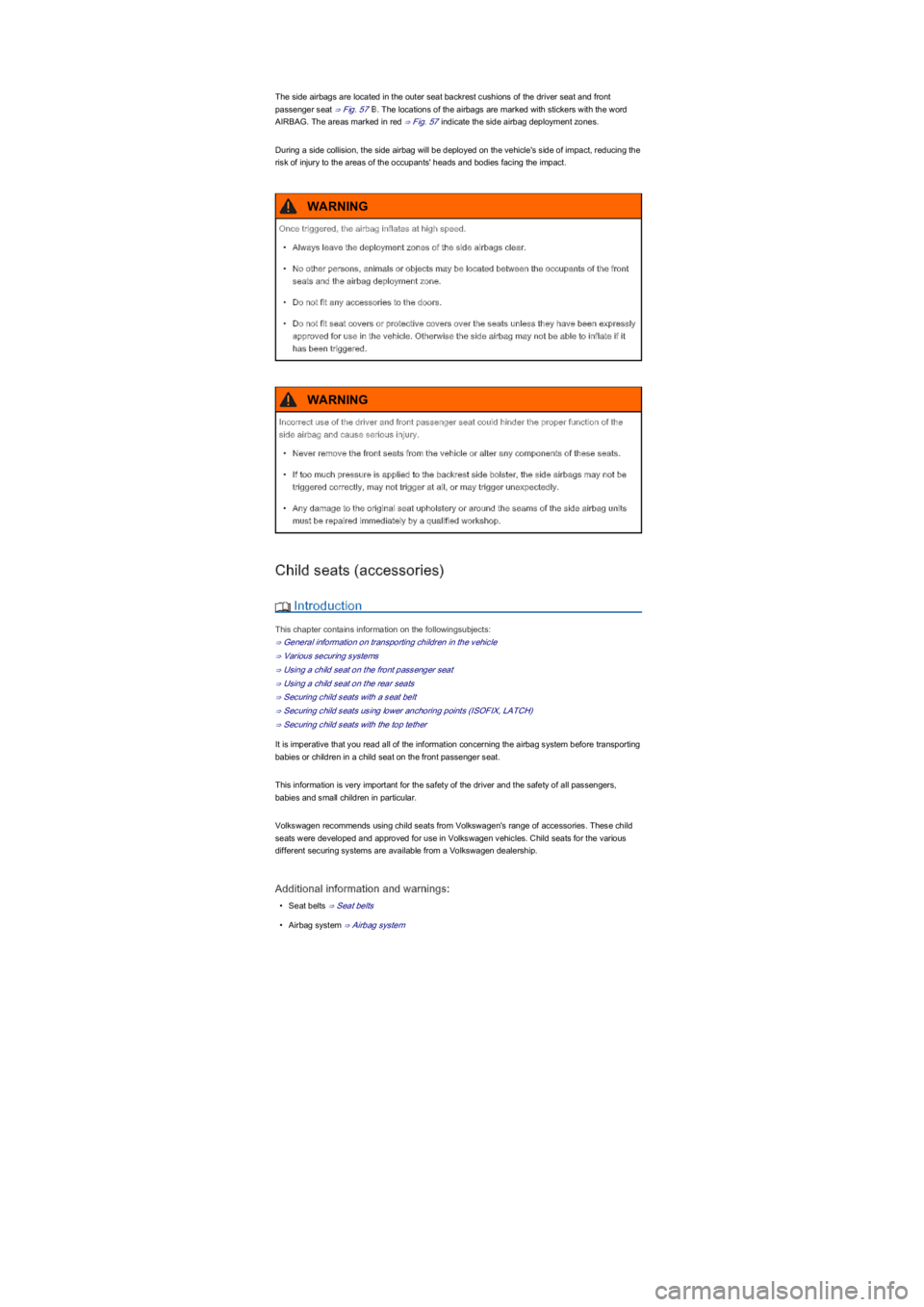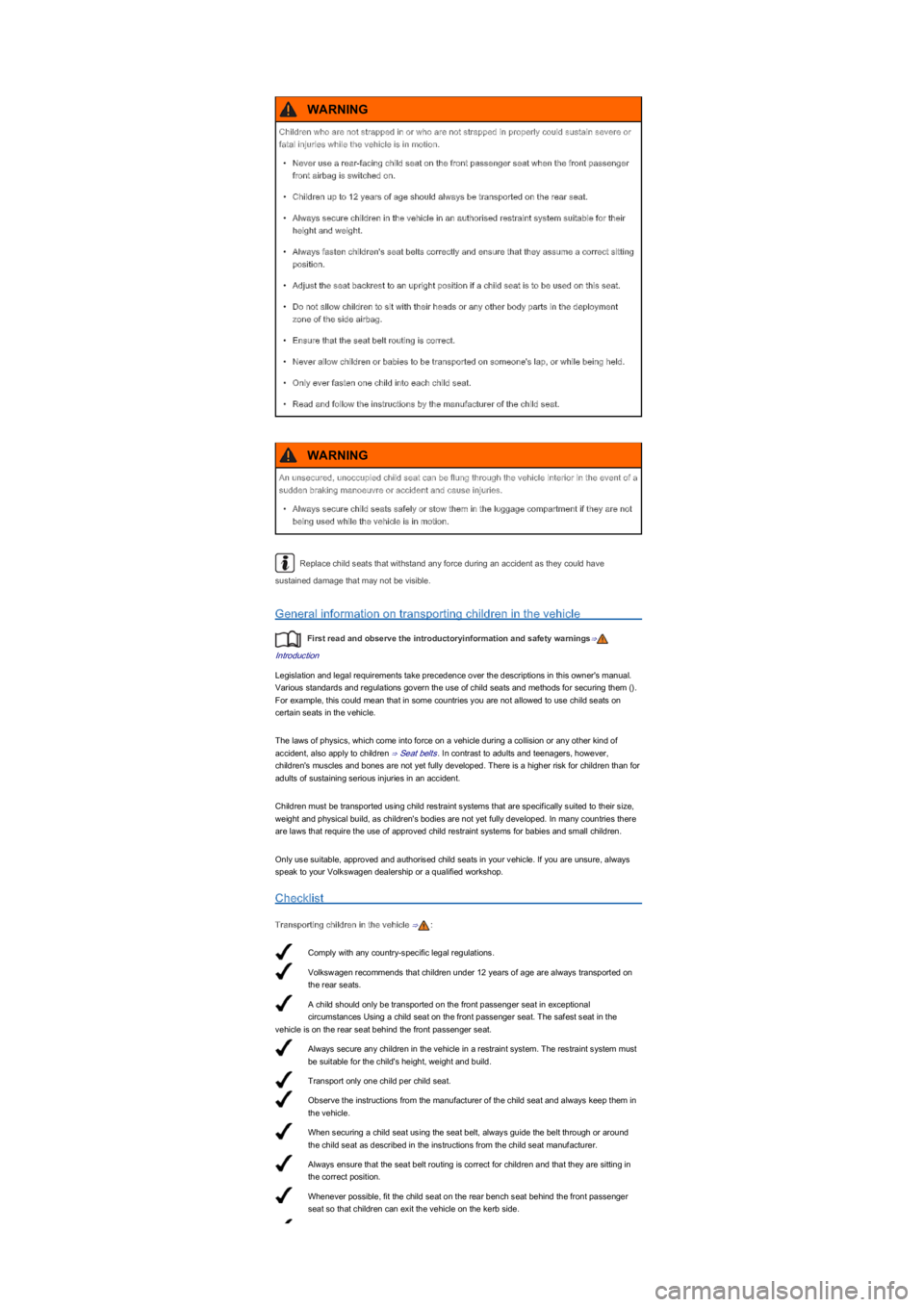Page 45 of 211
Fig. 49 Inserting the seat belt latch plate into the buckle
Fig. 50 Removing the latch plate from the buckle
First read and observe the introductoryinformation and safety warnings⇒
Introduction
During an accident or braking manoeuvre, correctly worn seat belts hold the vehicle occupants in
position in such a way as to provide maximum protection ⇒.
Fastening the seat belts
Fasten seat belts before every trip.
\f
Page 46 of 211
Fig. 52 Correct seat belt routing during pregnancy
First read and observe the introductoryinformation and safety warnings⇒
Introduction
Seat belts only provide an optimum level of protection during an accident when they are routed
correctly. Correct seat belt routing reduces the risk of severe or fatal injuries. Correct seat belt
routing also holds the vehicle occupants in position so that an inflating airbag can offer the
maximum level of protection. Therefore you must always fasten your seat belt and ensure that the
seat belt routing is correct.
Assuming an incorrect sitting position can cause severe or fatal injuries ⇒ Adjusting the seat
position.
Correct seat belt routing
\f
Page 47 of 211

The belt tensioners are activated by sensors during severe frontal, side and rear collisions. They
tighten the seat belts against the direction in which they are pulled. A loose seat belt is retracted,
which can reduce the forward movement or the movement of the vehicle occupants in the direction
of the impact. The belt tensioner works together with the airbag system. If the side airbags are not
activated, the belt tensioner will not be activated if the vehicle rolls over.
A fine dust may be produced when the airbags are triggered. This is quite normal and does not
mean that there is a fire in the vehicle.
Belt tension limiter
The belt tension limiter reduces the pressure exerted by the seat belt on the body during an
accident.
All safety requirements must be observed when the vehicle or components of the system are
scrapped. Qualified workshops are familiar with these requirements ⇒ Service and disposal of belt
tensioners.
Service and disposal of belt tensioners
First read and observe the introductoryinformation and safety warnings⇒
Introduction
Seat belts may become damaged during any work on the belt tensioners or while removing or
refitting any vehicle parts in conjunction with any other repair work. This damage will not always be
noticeable. The consequence may be that the belt tensioners could function incorrectly, or not
function at all, in the event of an accident.
Regulations must be observed to ensure that the effectiveness of the belt tensioner is not reduced
and that removed parts do not cause any injuries or environmental pollution. Qualified workshops
are familiar with these requirements.
The airbag modules and belt tensioners may contain perchlorate. Please comply with
legislation regarding disposal.
Airbag system
Introduction
This chapter contains information on the followingsubjects:
⇒ Types of front passenger front airbag system
⇒ Indicator lamps
⇒ Description and function of the airbags
⇒ Front airbags
⇒ Switching the front passenger front airbag on and off manually using the key-operated switch
⇒ Side airbags
The vehicle is equipped with a front airbag for the driver and front passenger. The front airbags can
provide front seat occupants with additional chest and head protection if the seat, seat belts, head
restraints and, in the case of the driver, steering wheel are adjusted and used correctly. Airbags are
meant only for additional protection. The airbags are not a substitute for seat belts. Seat belts must
always be worn, even when the front seats are equipped with front airbags.
Additional information and warnings:
\f
Page 48 of 211
Types of front passenger front airbag system
First read and observe the introductoryinformation and safety warnings⇒
Introduction
Never rely solely on the airbag system for your protection.
\f
Page 51 of 211

Fig. 54 Location and deployment zone of the driver front airbag
Fig. 55 Location and deployment zone of the front passenger front airbag
First read and observe the introductoryinformation and safety warnings⇒
Introduction
In conjunction with the seat belts, the front airbag system gives the front occupants additional
protection for the head and chest in the event of a severe frontal collision. Always keep as far away
from the front airbag as possible ⇒ Adjusting the seat position. This allows the front airbags to
inflate fully when triggered, thus providing maximum protection.
The front airbag for the driver is located in the steering wheel ⇒ Fig. 54 and the front airbag for the
front passenger is located in the dash panel ⇒ Fig. 55. The airbag locations are identified by the
text AIRBAG.
The areas inside the red lines ⇒ Fig. 54 and ⇒ Fig. 55 are covered by the front airbags when
triggered (deployment zoneyf�����)�R�U���W�K�L�V���U�H�D�V�R�Q�����\�R�X���P�X�V�W���Q�H�Y�H�U���O�H�D�Y�H���R�U���D�W�W�D�F�K���D�Q�\���R�E�M�H�F�W�V���L�Q���W�K�H�V�H�
areas ⇒. Any factory-fitted accessories will not be struck if the driver and front passenger front
airbags are deployed.
The airbag covers fold out of the steering wheel ⇒ Fig. 54 or dash panel ⇒ Fig. 55 when the driver
and front passenger front airbags trigger. The airbag covers remain connected to the steering
wheel or the dash panel.
Switching the front passenger front airbag on and off manually using
the key-operated switch
Once triggered, the airbag inflates at high speed.
\f
Page 52 of 211
Fig. 56 On the front passenger side: key switch for disabling and enabling the front airbag on the
front passenger side
First read and observe the introductoryinformation and safety warnings⇒
Introduction
The front passenger front airbag must be switched off when securing a rear-facing child seat to
the front passenger seat.
Disabling the front passenger front airbag
\f
Page 53 of 211

The side airbags are located in the outer seat backrest cushions of the driver seat and front
passenger seat ⇒ Fig. 57B. The locations of the airbags are marked with stickers with the word
AIRBAG. The areas marked in red ⇒ Fig. 57 indicate the side airbag deployment zones.
During a side collision, the side airbag will be deployed on the vehicle's side of impact, reducing the
risk of injury to the areas of the occupants' heads and bodies facing the impact.
Child seats (accessoriesyf
Introduction
This chapter contains information on the followingsubjects:
⇒ General information on transporting children in the vehicle
⇒ Various securing systems
⇒ Using a child seat on the front passenger seat
⇒ Using a child seat on the rear seats
⇒ Securing child seats with a seat belt
⇒ Securing child seats using lower anchoring points (ISOFIX, LATCHyf
⇒ Securing child seats with the top tether
It is imperative that you read all of the information concerning the airbag system before transporting
babies or children in a child seat on the front passenger seat.
This information is very important for the safety of the driver and the safety of all passengers,
babies and small children in particular.
Volkswagen recommends using child seats from Volkswagen's range of accessories. These child
seats were developed and approved for use in Volkswagen vehicles. Child seats for the various
different securing systems are available from a Volkswagen dealership.
Additional information and warnings:
\f
Page 54 of 211

Comply with any country-specific legal regulations.
Volkswagen recommends that children under 12 years of age are always transported on
the rear seats.
A child should only be transported on the front passenger seat in exceptional
circumstances Using a child seat on the front passenger seat. The safest seat in the
vehicle is on the rear seat behind the front passenger seat.
Always secure any children in the vehicle in a restraint system. The restraint system must
be suitable for the child's height, weight and build.
Transport only one child per child seat.
Observe the instructions from the manufacturer of the child seat and always keep them in
the vehicle.
When securing a child seat using the seat belt, always guide the belt through or around
the child seat as described in the instructions from the child seat manufacturer.
Always ensure that the seat belt routing is correct for children and that they are sitting in
the correct position.
Whenever possible, fit the child seat on the rear bench seat behind the front passenger
seat so that children can exit the vehicle on the kerb side.
Replace child seats that withstand any force during an accident as they could have
sustained damage that may not be visible.
General information on transporting children in the vehicle
First read and observe the introductoryinformation and safety warnings⇒
Introduction
Legislation and legal requirements take precedence over the descriptions in this owner's manual.
Various standards and regulations govern the use of child seats and methods for securing them (yf���
For example, this could mean that in some countries you are not allowed to use child seats on
certain seats in the vehicle.
The laws of physics, which come into force on a vehicle during a collision or any other kind of
accident, also apply to children ⇒ Seat belts. In contrast to adults and teenagers, however,
children's muscles and bones are not yet fully developed. There is a higher risk for children than for
adults of sustaining serious injuries in an accident.
Children must be transported using child restraint systems that are specifically suited to their size,
weight and physical build, as children's bodies are not yet fully developed. In many countries there
are laws that require the use of approved child restraint systems for babies and small children.
Only use suitable, approved and authorised child seats in your vehicle. If you are unsure, always
speak to your Volkswagen dealership or a qualified workshop.
Checklist
Transporting children in the vehicle ⇒:
Children who are not strapped in or who are not strapped in properly could sustain severe or
fatal injuries while the vehicle is in motion.
\f